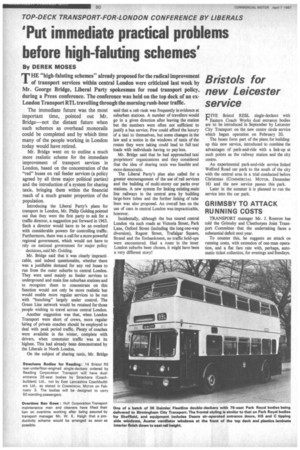'Put immediate practical problems before high-faluting schemes'
Page 52

If you've noticed an error in this article please click here to report it so we can fix it.
By DEREK MOSES
THE "high-faluting schemes" already proposed for the radical improvement of transport services within central London were criticized last week by Mr. George Bridge, Liberal Party spokesman for road transport policy, during a Press conference. The conference was held on the top deck of an exLondon Transport RTL travelling through the morning rush-hour traffic.
The immediate future was the most important time, pointed out Mr. Bridge—not the distant future when such schemes as overhead monorails could be completed and by which time many of the people working in London today would have retired.
Mr. Bridge went on to outline a much more realistic scheme for the immediate improvement of transport services in London, based on the concentration of the "red" buses on rail feeder services (a policy agreed by all three major political parties) and the introduction of a system for sharing taxis, bringing them within the financial reach of a much greater proportion of the population.
Introducing the Liberal Party's plans for transport in London, Mr. Philip Golding pointed out that they were the first party to ask for a traffic director, a suggestion put forward in 1963. Such a director would have to be an overlord with considerable powers for controlling traffic. Furthermore, there was a call for a more powerful regional goverrunent, which would not have to rely on national government for major policy decisions, said Mr. Golding.
Mr. Bridge said that it was clearly impracticable, and indeed questionable, whether there was a justifiable demand for any red buses to run from the outer suburbs to central London. They were used mainly as feeder services to underground and main line suburban stations and to recognize them to concentrate on this function would not only be more realistic but would enable more regular services to be run with "bunching" largely under control. The Green Line network would be retained for those people wishing to travel across central London.
Another suggestion was that, when London Transport were short of crews, more regular hiring of private coaches should be employed to deal with peak period traffic. Plenty of coaches were available in the winter, complete with drivers, when commuter traffic was at its highest. This had already been demonstrated by the Liberals in North London.
On the subject of sharing taxis, Mr. Bridge
Strachans Bodies for Reading ; 14 Bristol RE rear-underfloor-engined single-deckers ordered by Reading Corporation Transport will have dualentrance 26-seat bodies by Strachans (Coach builders) Ltd., not by East Lancashire Coachbui iders Ltd., as stated in COMMERCIAL MOTOR on February 3. The bodies will be designed to carry 50 standing passengers.
Overtime Ban Goes: Hull Corporation Transport maintenance men and cleaners have lifted their ban on overtime working after being assured by transport manager Mr. W. K. Haigh that a productivity scheme would be arranged as soon as possible.
said that a cab rank was frequently in evidence at suburban stations. A number of travellers would go in a given direction after leaving the station but the numbers were often not sufficient to justify a bus service. Few could afford the luxury of a taxi to themselves, but some changes in the law and a notice in the windows of taxis of the routes they were taking could lead to full taxi loads with individuals having to pay less.
Mr. Bridge said that he had approached taxi proprietors' organizations and they considered that the idea of sharing taxis was feasible and more democratic.
The Liberal Party's plan also called for a greater encouragement of the use of rail services and the building of multi-storey car parks over stations. A new system for linking existing main line railways in the central area by building large-bore tubes and the further linking of tube lines was also proposed. An overall ban on the use of cars in central London was impracticable, however.
Incidentally, although the bus toured central London via such roads as Victoria Street, Park Lane, Oxford Street (including the long one-way diversion), Regent Street, Trafalgar Square, Strand and the Embankment, no traffic hold-ups were encountered, Had a route in the inner London suburbs been chosen, it might have been a very different story!
































































































































































